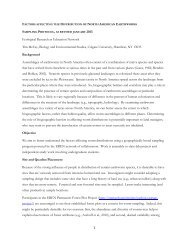Permanent Forest Plot Project (PFPP) - EREN
Permanent Forest Plot Project (PFPP) - EREN
Permanent Forest Plot Project (PFPP) - EREN
You also want an ePaper? Increase the reach of your titles
YUMPU automatically turns print PDFs into web optimized ePapers that Google loves.
Protocol, Data Sheets, and AppendicesCarbon Sequestration Rate:Carbon sequestration rate is calculated as the difference in carbon storage measured at twodifferent times, generally in increments of years (1, 5, or other). It is reported as kg C yr -1 .<strong>Forest</strong> Type:The plot can be classified into different forest types based upon the composition of speciesinventoried. The cover type is traditionally based upon the basal area of trees comprising themajority of the canopy, and the name includes the one, two, or sometimes three species predominantspecies. By convention, a species must make up at least 20% of the stand’s basal area to be includedin the name.A more complete description of standard US forest cover types can be found in the followingpublication.Eyre, F.H. (ed.)1980. <strong>Forest</strong> Cover Types of the United States and Canada. Society of American<strong>Forest</strong>ers. 148 pp.The publication is available for purchase from the Society of American <strong>Forest</strong>ers website:http://store.safnet.org/ (Accessed 14 June 2012)The pdf below includes a list of forest cover types include in the publication.http://el.erdc.usace.army.mil/emrrp/emris/EMRIS_PDF/<strong>Forest</strong>CoverTypes.PDFThe following website includes a list of forest cover types used by the US <strong>Forest</strong> Service inthe National <strong>Forest</strong> Inventory and Analysis (FIA).http://www.fs.usda.gov/detailfull/r5/landmanagement/gis/?cid=fsbdev3_047974&width=fullData Check and Data EntryTo enter Data online, your institution must be registered with the online database, andsomeone(s) from your institution must be registered as your Institution’s Administrator(s). Toregister your institution, and identify a site administrator, please email one of the <strong>Project</strong>’s currentLead Scientists, whose names and contact information are included on <strong>EREN</strong>’s <strong>PFPP</strong> webpage.Include in your email the name of your Institution, the name of the Administrator, and theAdministrator’s email address. Once the Lead Scientists have processed your request, theAdministrator will receive an email with instructions for logging on to the database. (Note: This maytake more than 24 hours, so please do this well in advance of the day that you hope to be able to enterSite/<strong>Plot</strong>/Tree data.)Once an Administrator has been registered for your Institution, the Administrator isresponsible for creating and entering Site information (only an Administrator can create Sites for anInstitution), registering other Users (Researchers) who can enter, edit, and upload <strong>Plot</strong>, Tree, andSmall Stem data to the <strong>PFPP</strong> Database website, and registering other Administrators for thatInstitution. All Administrators for an Institution can register Researcher Users for that Institution andapprove tree and small stem data that has been uploaded to the database. (Note: Approval isconfirmation that the data has undergone quality control measures and is ready for inclusion in thedatabase. All tree data must be approved by an Administrator before it becomes a permanent part ofthe database. )In addition to the Researcher Users who can enter <strong>Plot</strong> data and upload stem data, otherindividuals who register themselves with <strong>EREN</strong> as Users will be able to Query the database anddownload data. Users who download data will be asked to complete a form indicating the intendeduse of the data. (While Users can be anyone, this may often be the role assigned to students using the<strong>PFPP</strong> data for their classes.)11 June 2012 <strong>EREN</strong> (<strong>PFPP</strong> v 1.04) 20




